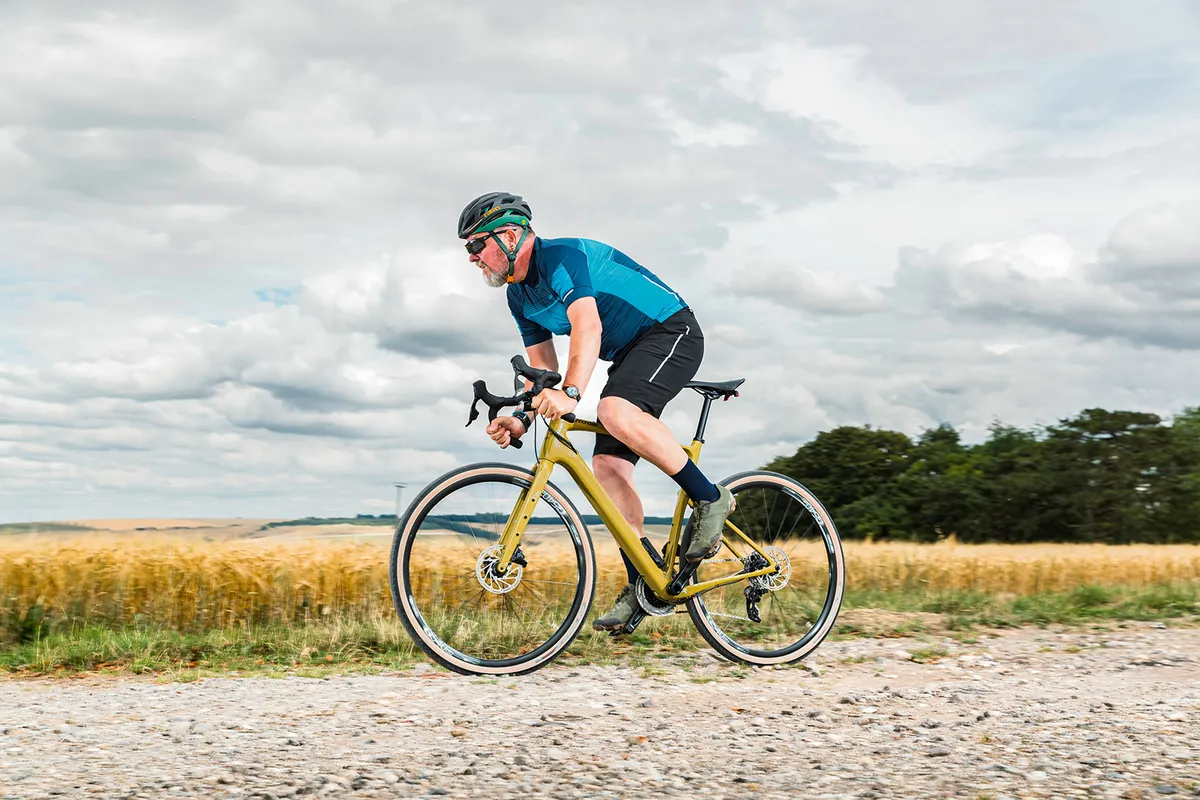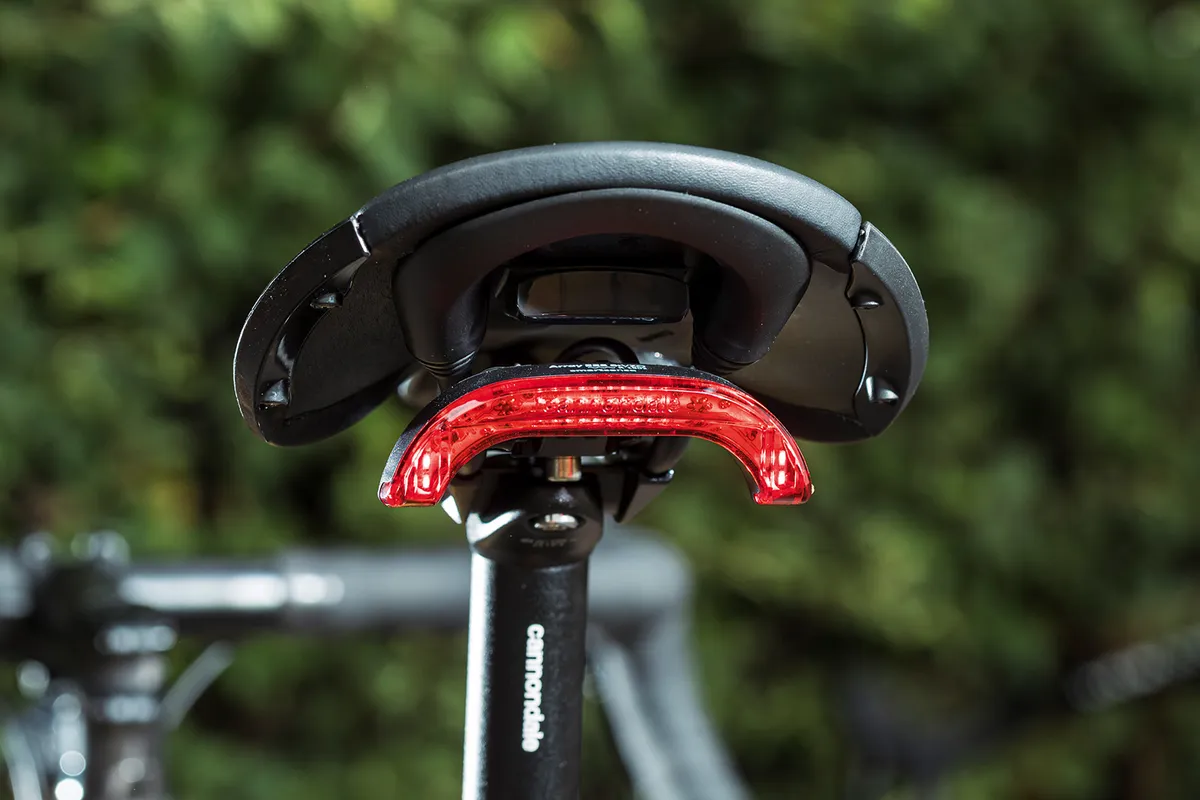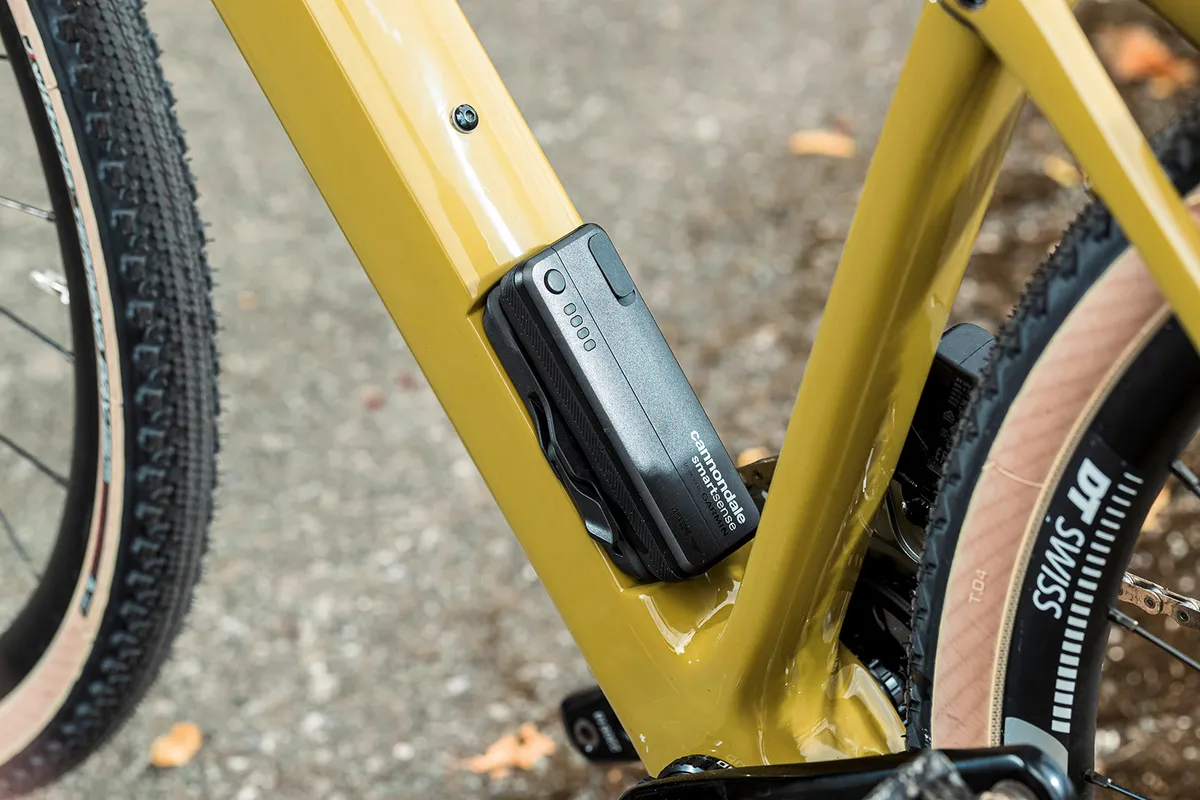The Cannondale Topstone is a mainstay of the gravel category and this latest update to the Topstone Carbon, introduced in April, offers a blend of versatility and fun, plus the addition of Cannondale's SmartSense technology.
Cannondale’s original Topstone Carbon brought the innovative Kingpin suspension rear end, inspired by the brand’s hardtail Scalpel mountain bike, with a single pivot at the point where the seatstays and seat tube meet.
Similar to a thru-axle in appearance, the design runs on bearings, with the carbon fibre in both the stays and seat tube designed to allow controlled flex that promises 30mm of travel at the saddle.
This new Topstone has the same technology, but Cannondale says it has refined the frame construction, reducing frame weight by 100g to a kilo.
It’s also worked hard to ensure that the ride feel is the same across all sizes, so the ‘leaf spring’-like design of the seat tube is proportional to frame size, and tyre clearance has been increased by 5mm, to 40mm with 700c wheels.
Cannondale Topstone Carbon Rival AXS geometry
Cannondale has also revised the geometry on the new Topstone Carbon, with an increased bottom bracket height and reduced standover.
This makes the Topstone ready for larger tyres without a negative effect on ride position, and a lower standover helps manoeuvrability when the going gets technical.
The ride position is a little sportier with the stack a full centimetre lower (size L), though reach is a little shorter (read our guide to stack and reach for more).
| | XS | S | M | L | XL |
|---|---|---|---|---|---|
| Effective seat angle (degrees) | 73.1 | 73.1 | 73.1 | 73.1 | 73.1 |
| Actual seat angle (degrees) | 71.4 | 71.6 | 71.8 | 71.9 | 72.1 |
| Head angle (degrees) | 70 | 71.2 | 71.2 | 71.2 | 71.2 |
| Chainstay (mm) | 420 | 420 | 420 | 420 | 420 |
| Seat tube (mm) | 410 | 458 | 505 | 553 | 590 |
| Top tube - hor (mm) | 533 | 544 | 557 | 572 | 587 |
| Top tube - actual (mm) | 503 | 516 | 532 | 550 | 567 |
| Head tube (mm) | 105 | 123 | 150 | 177 | 205 |
| Fork offset (mm) | 55 | 55 | 55 | 55 | 55 |
| Trail (mm) | 69 | 62 | 62 | 62 | 62 |
| Bottom bracket drop (mm) | 74 | 69 | 67 | 67 | 64 |
| Bottom bracket height (mm) | 278 | 283 | 285 | 285 | 288 |
| Wheelbase (mm) | 1,010 | 1,013 | 1,029 | 1,044 | 1,061 |
| Standover (mm) | 704 | 745 | 785 | 823 | 857 |
| Stack (mm) | 534 | 551 | 574 | 600 | 624 |
| Reach (mm) | 371 | 377 | 383 | 390 | 397 |
Off-road capability

All of the new Topstone Carbon's geometry changes amount to a bike that feels more at home on technical terrain, with an increase in the trail figure slowing the steering a little.
I’m hugely impressed by the smooth comfort of the back end, which matches the front end’s controlled and stable steering responses, and it inspires confidence when the going gets technical.
On tarmac, the Topstone feels like a cruising, endurance road bike, making it a superb companion on the roads between trails.
Indeed, while the Topstone Carbon may have moved more off-road than ever, with its wider tyre clearance and various mounts (on the top tube and fork), it’s also a very capable road machine when needed.
2x gearing
The choice of a 2x SRAM Rival AXS drivetrain over the gravel-specific Rival XPLR 1x drivetrain seems a little unconventional for gravel, but more conventional for riding on the road.
Ultimately, whether you prefer a 1x or 2x drivetrain for gravel riding depends on your preferences as a rider – where and how you ride – and what you want from your gravel bike setup.
As far as the Topstone Carbon Rival AXS is concerned, the 43/30t crankset and 10-36t cassette provide the close ratios traditional roadies approve of, plus a suitable range for typical off-road climbs.
The rear derailleur, with its sprung clutch, is a bonus on rougher stuff because it stops excessive chain bounce.
The powerful Rival hydraulic disc brakes, with 160mm rotors front and rear, have bags of feel, which adds to the handling that makes this bike lots of fun, whether on singletrack trails, wide-open dirt roads or tarmac.

Chunky wheels and tyres
The DT Swiss G540 wheels combine DT’s Spline hubs with a wide, tubeless-ready rim that has a broad 24mm internal rim width.
Owing to component availability, our bike is shod with Vittoria’s Terreno Dry tanwall tyres in a 38c width, instead of the 44c Vittoria Mezcal III tyres listed on the spec sheet.
The substitution really worked for me; in one of the driest, hottest summers in British history, when testing primarily took place, the low-profile knobbled tread of the Terrenos was superb on dusty trails.
They offer impeccable levels of bite in the corners, while the textured central tread makes them fast-rolling on the road and hard-packed dirt, too.
The Mezcal is described as a 'versatile all-rounder' for dry conditions and mixed terrain. Tyre choice is key when it comes to gravel bikes, so check what your bike will come with.
Swapping in a set of the best gravel tyres for your riding is also one of the smartest (and easiest) upgrades you can make to your gravel bike.
Elsewhere, the build combines Cannondale alloy components in the form of its 1 alloy stem and 2 ShortDrop alloy bar, which has a subtle flare to work well both on and off-road.
Once again, component shortages also meant a few more deviations from Cannondale’s official specification, so our test bike came with a 3 alloy post and Fizik’s Aliante saddle, which both did a fine job yet added a few grams.
Integrated lights

Perhaps a controversial choice for the new Topstone is the inclusion of the integrated SmartSense lights first seen on the Synapse.
The heart of the SmartSense system is a down-tube mounted power pack with a claimed five-hour run time in standard mode.
As we've previously covered in our Cannondale Synapse review, integrated lights aren’t to everyone’s taste or requirements, but they do mean you always have lights available when required, and only one battery to charge.

The 350-lumen front light has enough power to light unlit back roads, with careful riding.
Meanwhile, the back light’s broad U-shaped lens is plenty bright enough for other road users to see you from a distance.
The under-stem front light means a bar bag will block the light, however.
If you want enough illumination for off-road night riding, you'll need to look at a set of more powerful, dedicated bike lights (or a set of mountain bike lights if you want to really turn night into day).
Cannondale Topstone Carbon Rival AXS bottom line
This is a truly modern gravel bike, but it also has versatility in its DNA.
The SmartSense lights are a commuter’s friend and the Kingpin suspension unleashes the bike in the rough, while the gearing choice and handling will help you keep up with roadie mates.
Product
| Brand | cannondale |
| Price | 4850.00 GBP |
| Weight | 10.1900, KILOGRAM (L) - |
Features
| Fork | Full carbon |
| br_stem | Cannondale 1 alloy |
| br_frame | Carbon, Kingpin suspension system |
| Tyres | Vittoria Mezcall III 44c |
| br_brakes | SRAM Rival, 160mm Paceline rotors |
| br_cranks | SRAM Rival AXS DUB Wide with 43/30t chainrings |
| br_saddle | Fizik Terra Argo X5 |
| br_wheels | DT Swiss G540 |
| br_shifter | SRAM Rival eTap |
| br_cassette | SRAM XG-1250 10-36t 12-speed |
| br_seatpost | Cannondale SAVE Carbon SmartSense |
| br_handlebar | Cannondale 2 ShortDrop alloy |
| br_bottomBracket | SRAM DUB BSA |
| br_availableSizes | XS, S, M, L, XL |
| br_rearDerailleur | SRAM Rival eTap |
| br_frontDerailleur | SRAM Rival eTap |
